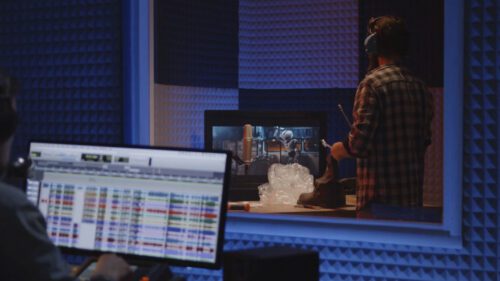Whether you’ve realized it or not, you’ve sat through two different types of music in all sorts of media. From music videos to commercials to business presentations to Hollywood films, all of them use either one type or the other.
Think you know what I’m talking about already? I’ll give you a hint: it has nothing to do with instruments or genre. It’s not royalty-free and licensed music either. No, these two types are much more comprehensive than that. And you’re going to want to know what they are so you can use music as effectively as possible in your videos.
What are Diegetic and Non-Diegetic Music?
Film music and movie soundtracks can be described as being either diegetic or non-diegetic—both derived from the literary term “diegesis.”
Determining whether a piece of music is one or the other comes down to the context in which it is used. Can the characters hear it? Does the audience realize this? Or is the song used to increase emotional resonance?
Below we’ll dive deeper into what this means, take a look at a few examples, and examine how to use both types in your projects.
Diegetic Music
When film music is referred to as “diegetic,” it means it comes from within the “narrative sphere” of the story. That is, the music can be heard, played, or manipulated by the characters.
Think of how a character might turn on a radio in a car to listen to a song. Or go to a club where the music is playing far too loud. Diegetic types of music are important because they are prompted by, and sometimes even effect, the story of your video.
This Heineken commercial, for example, bases its entire premise around the use of Biz Markie’s “Just a Friend” as a piece of diegetic music. Here’s another example of diegetic music from “Back to the Future”:
As seen in the clip above, the music is dictated by the storyline (Marty being on stage with a band), and the characters react to it. The music is from within the world of the story—and has the potential to change that world as well.
Non-Diegetic Music
When you think of movie soundtracks (e.g., orchestra pieces), you typically don’t imagine diegetic music. For a piece of music to be non-diegetic, it has to exist separately from the characters. The music exists solely for the audience and is typically used to influence their emotional reaction to a scene.
Here’s another scene from “Back to the Future,” but this time with non-diegetic music. Instead of the song coming from within the world, it is applied over top of it:
In this clip, the powerful score intensifies the action, but it’s clear that neither Marty nor the Libyan rebels are able to hear it. However, by supplying the audience with music, the filmmakers add a tone of danger, accelerating the pacing and providing an overall greater experience.
How to Use Diegetic Music
Now that you know the difference between the two types of soundtrack music, it’s time to learn how to use each of them seamlessly, starting with diegetic (in-story) music.
Establish a Source
To make diegetic music work effectively, the first thing you need to do is establish the music is coming from within the scene. There are many ways you can do this:
- – Show a radio turned on by a character
- – Have a character play an instrument
- – Utilize a setting in which music is common (restaurants, grocery stores, etc.)
- – Have characters react to the song by dancing or singing
As a general rule, if you want to use diegetic music, you have to plan for it ahead of time since you have to establish a source inside the footage.
Use Sound Filters
Once you’ve settled on the environment and the source of the music, you have to make it believably sound like it’s coming from that source.
For instance, say your character walks into a room, hides a radio under her pillow, then turns on the music. Since the radio would be muffled by the pillow, the music shouldn’t come out crisp and clean.
There are various sound filters you can use to make these effects, some of them automatically. If you aren’t sure how to make it sound believable, try recalling your own experiences and expectations:
- – If it’s a brand new MP3 player in the scene, it should sound boisterous and bold.
- – If it’s over the intercom speakers of a hotel, it should sound muted and tinny.
- If it’s coming from another room in a house, it should sound distant and quiet.
Basically, it has to sound like you’d expect it to sound in real life—and sound filters help sell that credibility.
Time Appropriately
The last and final step is to either transition your music away from its diegetic source or end it completely. At this point, what you do and how you do it is going to be a stylistic choice.
The answer could be as simple as having your character stop playing an instrument or arriving at a destination in a car and turning off the radio. Alternatively, you might use editing techniques to end a song by fading out or using jump cuts.
How to Use Non-Diegetic Music
Using non-diegetic (out-of-story) music is both easier and more difficult at the same time. Technically, overlaying a song on top of a video is easy, but as a matter of style, choosing the appropriate song and cueing it at the right time can be difficult.
Still, music is essential to many movies, so having the ability to apply it correctly is invaluable.
Provide Cues
Generally speaking, music that begins in the middle of a line or randomly within a scene draws too much attention to itself to be effective.
Instead, make sure you have a smooth transition or cue for it. It could be a dramatic reveal (visually or verbally), a quick scene change, or as simple as a slow fade-in.
For some projects, you’ll want to introduce music with subtlety, while with others, you’ll choose to jolt the audience by surprising them with a song.
Mix with Care
Few things are more frustrating than trying to watch a movie and not being able to hear what the characters are saying. This isn’t always because of the music, of course; however, a soundtrack is just one more thing to distract us from listening to dialogue or hearing crucial sound effects.
When you reach the stage of your production where you’re mixing audio, be meticulous about volume levels. You want the music to be loud enough to be heard and enjoyed, but it shouldn’t overtake dialogue (unless it’s an intentional choice).
Follow the Emotion
The conventional way of using music in a movie is to have it inform the audience as to how you you think they should feel—like using a sad piano ballad as someone passes on their deathbed.
But conventional isn’t always best. Martin Scorsese, a master of film soundtracks, often uses music in his films that is emotionally opposite of what you’d expect so that the audience is forced to claim an emotion on their own. Sometimes providing the emotional piano music after the character has died is actually more powerful.
Transitioning Between the Two
One of the most difficult things to pull off is a transition between diegetic and non-diegetic music. However, audio crossfades and slow volume increases or decreases work well for this.
Another technique is to suddenly play the music louder. You can also associate the transition with a visual cue—like a door slam or sudden jump cut. Keep in mind that when you use both types of music at once, you have to be thinking about the audience’s reactions and those of your characters.



